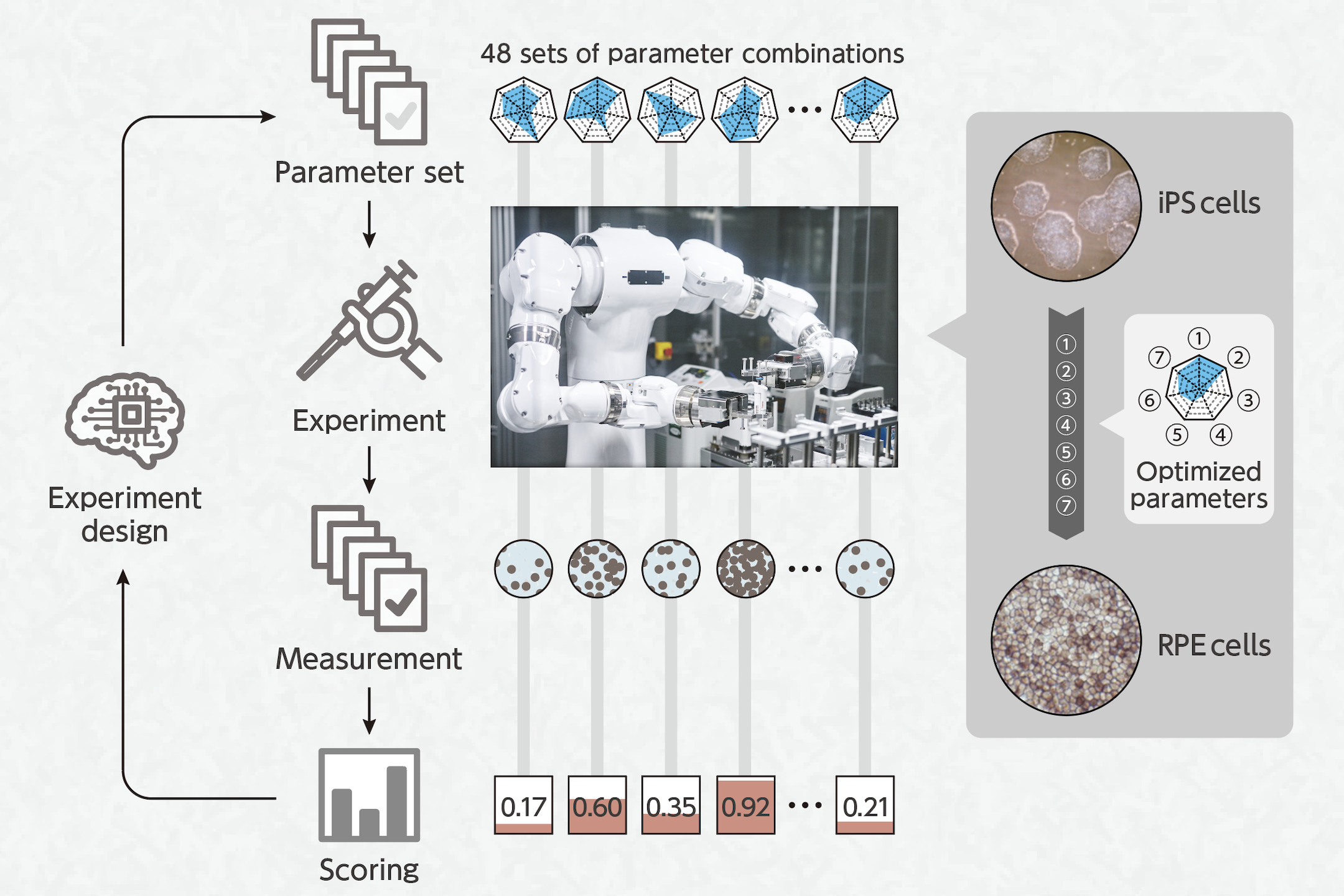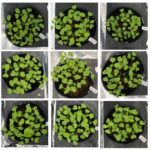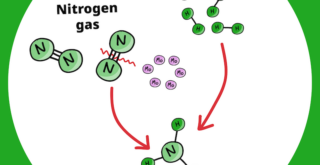A joint research group led by Genki Kanda at the RIKEN Center for Biosystems Dynamics Research (BDR) has developed a robotic artificial intelligence (AI) system for autonomously determining the optimal conditions for growing replacement retina layers necessary for vision. The AI controlled a trial and error process spanning 200 million possible conditions that succeeded in improving cell culture recipes used in regenerative medicine. This achievement, published in the scientific journal eLife on June 28, is just one example of how the automated design and execution of scientific experiments can increase the efficiency and speed of life science research in general.
Research in regenerative medicine often requires numerous experiments that are both time-consuming and labor-intensive. In particular, creating specific tissue from stem cells—a process called induced cell differentiation—involves months of work, and the degree of success depends on a wide range of variables. Finding the optimal type, dose, and timing of reagents, as well as optimal physical variables such as pipette strength, cell transfer time, and temperature is difficult and requires an enormous amount trial and error. As Kanda explains, “because minute differences in physical conditions have a significant impact on quality, and because inducing cell differentiation takes weeks to months of time in culture, the impact of a tiny difference in timing on day 3 might not be detected for several months.”
To make this process more efficient and practical, the BDR team set out to develop an autonomous experimental system that can determine the optimal conditions and grow functional retinal pigment layers from stem cells. Retinal pigment epithelium (RPE) cells were chosen because degeneration of these cells is a common age-related disorder that leaves people unable to see. Equally important, transplanted RPE retinal layers have already been shown to have some clinical success.
For autonomous experiments to be successful, the robot must repeatedly produce the same series of precise movements and manipulations, and the AI must be able to evaluate the results and formulate the next experiment. The new system accomplishes these goals using a general-purpose humanoid robot – named Maholo – capable of highly precise life science experimental behavior. Maholo is controlled by AI software that uses a newly designed optimization algorithm to determine which parameters should be changed, and how they should be changed, to improve differentiation efficiency in the next round of experiments.
Researchers input the necessary protocols for generating RPE cells from stem cells into Maholo. While RPE cells were successfully generated in all experiments, efficiency was only 50%. Thus, for every 100 stem cells, only about 50 became RPE cells. After establishing this baseline, the AI initiated the optimization process to determine the best conditions among all chemical and physical parameters. What would have taken humans over two and a half years to complete only took the robotic AI system 185 days, and resulted in a 90% rate of differentiation efficiency. Practically, these cells displayed many of the typical biological markers that would make them suitable for transplant into an eye with a damaged RPE cell layer.
The success of the new system goes beyond the immediate results. “We chose to differentiate RPE cells from stem cells as a model,” says Kanda, “but in principle, combining a precision robot with the optimization algorithms will enable autonomous trial and error experiments in many areas of life science.”
However, the researchers emphasize that the goal of the study is not to replace human lab workers with robots. “Using robots and AI for carrying out experiments will be of great interest to the public,” says Kanda. “However, it is a mistake to see them as replacements. Our vision is for people to do what they are good at, which is being creative. We can use robots and AI for the trial-and-error parts of experiments that require repeatable precision and take up a lot of time, but do not require thinking.” ??
Research in regenerative medicine often requires numerous experiments that are both time-consuming and labor-intensive. In particular, creating specific tissue from stem cells—a process called induced cell differentiation—involves months of work, and the degree of success depends on a wide range of variables. Finding the optimal type, dose, and timing of reagents, as well as optimal physical variables such as pipette strength, cell transfer time, and temperature is difficult and requires an enormous amount trial and error. As Kanda explains, “because minute differences in physical conditions have a significant impact on quality, and because inducing cell differentiation takes weeks to months of time in culture, the impact of a tiny difference in timing on day 3 might not be detected for several months.”
To make this process more efficient and practical, the BDR team set out to develop an autonomous experimental system that can determine the optimal conditions and grow functional retinal pigment layers from stem cells. Retinal pigment epithelium (RPE) cells were chosen because degeneration of these cells is a common age-related disorder that leaves people unable to see. Equally important, transplanted RPE retinal layers have already been shown to have some clinical success.
For autonomous experiments to be successful, the robot must repeatedly produce the same series of precise movements and manipulations, and the AI must be able to evaluate the results and formulate the next experiment. The new system accomplishes these goals using a general-purpose humanoid robot – named Maholo – capable of highly precise life science experimental behavior. Maholo is controlled by AI software that uses a newly designed optimization algorithm to determine which parameters should be changed, and how they should be changed, to improve differentiation efficiency in the next round of experiments.
Researchers input the necessary protocols for generating RPE cells from stem cells into Maholo. While RPE cells were successfully generated in all experiments, efficiency was only 50%. Thus, for every 100 stem cells, only about 50 became RPE cells. After establishing this baseline, the AI initiated the optimization process to determine the best conditions among all chemical and physical parameters. What would have taken humans over two and a half years to complete only took the robotic AI system 185 days, and resulted in a 90% rate of differentiation efficiency. Practically, these cells displayed many of the typical biological markers that would make them suitable for transplant into an eye with a damaged RPE cell layer.
The success of the new system goes beyond the immediate results. “We chose to differentiate RPE cells from stem cells as a model,” says Kanda, “but in principle, combining a precision robot with the optimization algorithms will enable autonomous trial and error experiments in many areas of life science.”
However, the researchers emphasize that the goal of the study is not to replace human lab workers with robots. “Using robots and AI for carrying out experiments will be of great interest to the public,” says Kanda. “However, it is a mistake to see them as replacements. Our vision is for people to do what they are good at, which is being creative. We can use robots and AI for the trial-and-error parts of experiments that require repeatable precision and take up a lot of time, but do not require thinking.” ??
Further reading
Kanda et al. (2022) Robotic search for optimal cell culture in regenerative medicine. eLife. doi: 10.7554/eLife.77007
Further reading
Kanda et al. (2022) Robotic search for optimal cell culture in regenerative medicine. eLife. doi: 10.7554/eLife.77007












